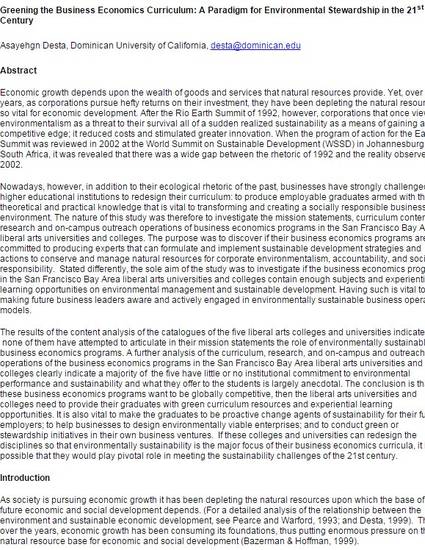
Article
Greening the Business Economics Curriculum: A Paradigm for Environmental Stewardship in the 21st Century
Journal of Business and Public Affairs
(2007)
Abstract
Economic growth depends upon the wealth of goods and services that natural resources provide. Yet, over the years, as corporations pursue hefty returns on their investment, they have been depleting the natural resources so vital for economic development. After the Rio Earth Summit of 1992, however, corporations that once viewed environmentalism as a threat to their survival all of a sudden realized sustainability as a means of gaining a competitive edge; it reduced costs and stimulated greater innovation. When the program of action for the Earth Summit was reviewed in 2002 at the World Summit on Sustainable Development (WSSD) in Johannesburg, South Africa, it was revealed that there was a wide gap between the rhetoric of 1992 and the reality observed in 2002.
Nowadays, however, in addition to their ecological rhetoric of the past, businesses have strongly challenged higher educational institutions to redesign their curriculum: to produce employable graduates armed with the theoretical and practical knowledge that is vital to transforming and creating a socially responsible business environment. The nature of this study was therefore to investigate the mission statements, curriculum contents, research and on-campus outreach operations of business economics programs in the San Francisco Bay Area liberal arts universities and colleges. The purpose was to discover if their business economics programs are committed to producing experts that can formulate and implement sustainable development strategies and actions to conserve and manage natural resources for corporate environmentalism, accountability, and social responsibility. Stated differently, the sole aim of the study was to investigate if the business economics programs in the San Francisco Bay Area liberal arts universities and colleges contain enough subjects and experiential learning opportunities on environmental management and sustainable development. Having such is vital to making future business leaders aware and actively engaged in environmentally sustainable business operating models.
The results of the content analysis of the catalogues of the five liberal arts colleges and universities indicate that none of them have attempted to articulate in their mission statements the role of environmentally sustainable business economics programs. A further analysis of the curriculum, research, and on-campus and outreach operations of the business economics programs in the San Francisco Bay Area liberal arts universities and colleges clearly indicate a majority of the five have little or no institutional commitment to environmental performance and sustainability and what they offer to the students is largely anecdotal. The conclusion is that if these business economics programs want to be globally competitive, then the liberal arts universities and colleges need to provide their graduates with green curriculum resources and experiential learning opportunities. It is also vital to make the graduates to be proactive change agents of sustainability for their future employers; to help businesses to design environmentally viable enterprises; and to conduct green or stewardship initiatives in their own business ventures. If these colleges and universities can redesign the disciplines so that environmentally sustainability is the major focus of their business economics curricula, it is possible that they would play pivotal role in meeting the sustainability challenges of the 21st century.
Disciplines
Publication Date
2007
Publisher Statement
Originally published as Desta, A. (2007). Greening the Business Economics Curriculum: A Paradigm for Environmental Stewardship in the 21 st Century. Journal of Business and Public Affairs, 1(1).
Citation Information
Asayehgn Desta. "Greening the Business Economics Curriculum: A Paradigm for Environmental Stewardship in the 21st Century" Journal of Business and Public Affairs Vol. 1 Iss. 1 (2007) Available at: http://works.bepress.com/asayehgn_desta/27/
